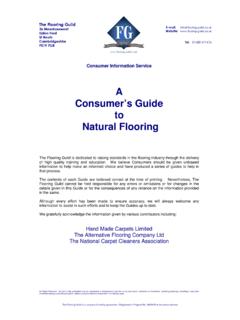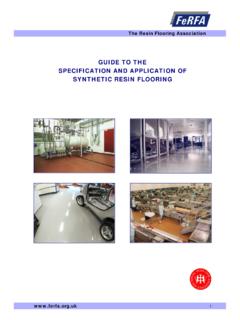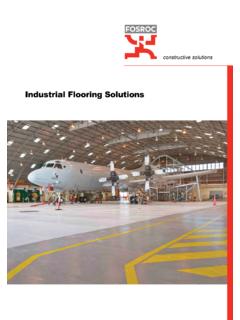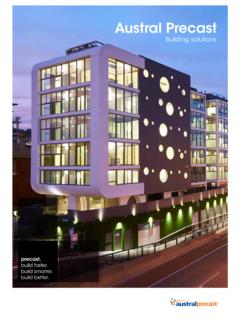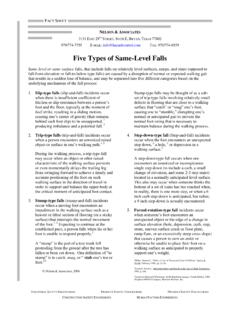Transcription of Slips and trips - hse.gov.uk
1 Health and Safety ExecutivePage 1 of 7 This checklist will help you identify slip and trip hazards in your workplace and decide what action to take. It will be of benefit to anyone who assesses and manages Slips and trips at checklist provides examples of hazards that can be found in and around workplaces, and suggests actions that you can take to resolve them. The list tries to cover as many slip and trip hazards as possible. Some may not apply to you, while you may come across others not mentioned here, but which you will need to consider. Room has been left on the checklist for you to add any hazards that are specific to your get the most from the checklist, you will need to walk through your workplace, including the outside grounds as appropriate, speak to union and employee safety representatives, workers and others to get their views of hazards and risks in the workplace, and then together decide what you could practically do to put them right.
2 It is important to take action once a hazard has been mapping toolThis checklist can be used in conjunction with the risk mapping tool The mapping tool can help you to identify high-risk locations and hazards in your workplace and people who may be at riskYou can also use this checklist to feed into your broader health and safety risk assessment process. More guidance on risk assessment can be found at Slips and tripsHazard spotting checklist Health and Safety ExecutiveSlips and trips : Hazard spotting checklist Page 2 of 7 Slips and trips hazard spotting checklistPotential issueTick if yes Suggested actionOutdoor areasCan anything be found on the paths, steps and fire escapes that could cause Slips , eg build-up of leaves, wet grass, moss, mud etc?
3 Set up a regular work schedule for clearing paths, tackle busy routes cutting back plants and trees that overlap paths prone to ice build-up during winter months?Consider alternative, safer weather conditions and put a winter procedure in place, eg there any changes in level on the path that are not easy to see, eg small slopes?Highlight hazard improve lighting, apply contrasting eye-catching colour to slope (eg non-slip paint, flush-fitting bolt-on material).Are there holes, potholes, or uneven paving on footpaths?Barrier off area as a temporary solution, ensure barriers cannot be easily moved.
4 Highlight hazard, eg improve lighting, use eye-catching colour on defective area as a temporary required fill in holes, re-lay paving, replace broken paving fire escapes slippery when wet?Improve grip consider applying slip-resistant coating/strips or bolt-on slip-resistant material (caution do not create a trip hazard). DoorwayIs the floor between the building threshold (entrance) and the entrance matting slippery when wet? Improve grip consider extending mat or exterior paving, applying slip-resistant coating/strips or changing to more slip-resistant there water on the floor from rain etc?
5 Is it making the floor slippery?Stop water entering building construct canopies over entrances, improve external drainage, keep doors closed when you water spreading fit large and absorbent entrance mats to dry water quickly review cleaning system, introduce dry mopping, consider introducing heaters/underfloor heating to speed up drying time. Improve grip consider fitting slip-resistant flooring. Health and Safety ExecutiveSlips and trips : Hazard spotting checklist Page 3 of 7 Potential issueTick if yes Suggested actionEntrances (continued)Are there any trip hazards in the area, eg trailing cables, deliveries, mats with curled up edges, or other objects?
6 Housekeeping needed tidy away cables, provide safe delivery storage area, clear away boxes and equipment, fix down mat edges or replace if necessary. Corridors and officesAre there any subtle changes in floor level, eg slopes, small steps, abrupt changes from one flooring material to another?Highlight hazard improve lighting, use eye-catching colour on slope/step, clearly highlight change from one flooring material to the floors smooth in areas where contamination can be found on the floor (eg liquids, food and food wrappers, dusts, polythene, condensation etc?)Stop contamination from getting onto floor provide bins for litter, fix leaks, fit lids on containers, close doors leading from working spreading drip trays beneath plants/machines/water contamination quickly review cleaning system, spot clean spills, dry mop large wet areas, vacuum/brush up dry the tiles or flooring becoming unstuck or curling at the edges?
7 Are there holes?Maintenance required fix down tiles and carpet edges, replace if necessary, fill in holes, replace cracked the anti-slip floor coating or grip tape worn smooth or damaged?Maintenance required replace damaged and worn changing there any trip hazards around workstations or in corridors and walkways, eg trailing cables, boxes, deliveries, equipment or other objects?Housekeeping needed keep walkways clear, tidy away or use cable covers, provide additional storage, clear away boxes and light levels too low to see the floor surface clearly?Improve lighting new bulbs, additional light reflecting on the smooth flooring creating glare?
8 Improve lighting re-angle lights, install blinds or anti-glare grills or glazing removing floor surface shine. Stairs and rampsAre step nosings (edge of step) hard to see, rounded, damaged or slippery?Check lighting is sufficient to see step edges the very edge of the step with a nosing that has a high visibility, square edge and non-slip finish. For difficult to replace round-edged nosing, ensure non-slip edging wraps right around the edge of the and Safety ExecutiveSlips and trips : Hazard spotting checklist Page 4 of 7 Potential issueTick if yes Suggested actionStairs and ramps (continued)Are handrails available?
9 Are they easy to reach and useable?Provide a handrail on at least one side of the stairs; if flight of stairs is wider than 1 m, provide handrails on both sides and a third, middle handrail if 2 m or wider. Handrail heights should be between 900 mm and 1000 mm and be parallel to the pitch line (slope) of the flight of stairs. On landings where the handrail provides guarding the height should be 1100 for handrail shape, diameter and distance from wall can be found in the Building Regulations and British the height (rise) of the steps or depth of tread (going) inconsistent throughout the flight?
10 Highlight the problem, eg with warning the rise/going of the stairs so they are all of equal the stair treads slippery?Thoroughly clean on a regular basis to remove stair covering with one with better slip any ramps or slopes in or around the workplace difficult to see?Highlight ramp with contrasting colour and check lighting grip consider fitting slip-resistant with flights of stairs, consider providing handrails. Work areas and work platforms (eg kitchens, warehouses, storerooms)As part of the work process, is contamination (fluids, solids, dust, debris etc) getting onto the floor?










